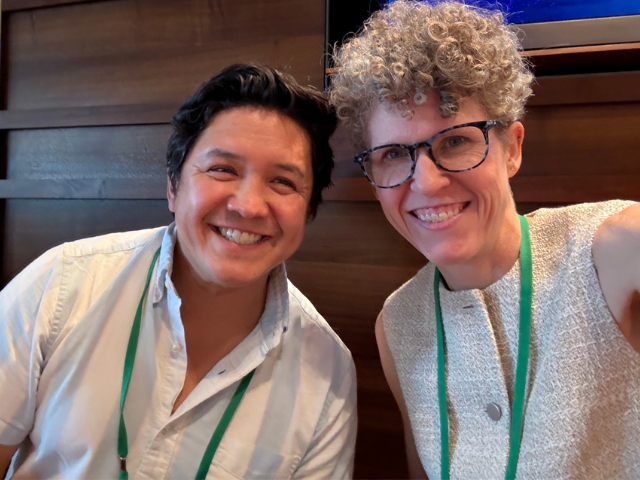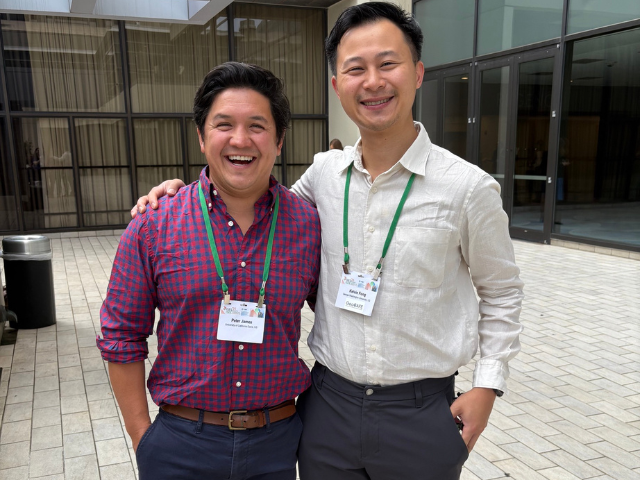
Global Insights on Greenspace & Health
Key Takeaways from ISEE-ISES 2025
Quick Summary
- At ISEE-ISES 2025, scientists shared how trees, parks & green spaces affect health worldwide—from child survival to brain health.
- The big takeaway? 🌳 Greenspace matters, but it’s not one-size-fits-all—it depends on design, place & people.
At the end of summer each year, the International Society for Environmental Epidemiology (ISEE) conference is a highlight for those of us working at the intersection of environment, epidemiology, and public health. This year’s meeting in Atlanta "Global Environmental Health Equity across the Lifespan" was no exception. It was four days of lively conversations, late-night brainstorming (as well as some dancing and karaoke), and the kind of serendipitous encounters that remind me why in-person conferences still matter.

This year, the conference was co-hosted with the International Society for Exposure Science (ISES), which brought another invigorating group of exposure scientists into the mix. Walking through the conference, you’d overhear snippets of science being shared over coffee, sparks of collaboration being born in real time. For me, the magic of ISEE-ISES is not just the science (though it’s always cutting-edge), but the way it brings together researchers from around the globe, all committed to tackling some of the most pressing environmental health challenges of our time.
One of the highlights of my week in Atlanta was presenting in a session called “Greenspace and Health Around the World.” The talks in this session took us across continents and age groups, exploring the many ways that greenspaces—trees, parks, forests, and urban greenery—affect human health. What struck me most was how diverse the studies were: different exposures, different health outcomes, different populations, yet a common theme emerged—greenspace matters, but not always in the same way, and not always as straightforwardly as we might assume. Let me take you through some of the incredible research that was shared.
Greenspace and Health Around the World
Trees, Configuration, and Child Survival in Low- and Middle-Income Countries
The session opened with a truly global study from a team spanning Singapore, New Zealand, China, and beyond. Their question was deceptively simple: Does the configuration of trees matter for child health? A number of studies have shown that tree canopy cover is linked with better health outcomes, but this study pushed us to think beyond pure coverage alone.
The researchers looked at more than 400,000 children under five in 59 low- and middle-income countries, linking survival data with metrics of tree canopy structure around each community. Instead of just measuring “how green” a neighborhood is, they asked: how are those green patches arranged? Are they scattered or clumped?
The findings were pretty interesting. More aggregated, clustered patches of tree canopy were associated with reduced child mortality risk. A 1% increase in their “aggregation index” translated into measurable reductions in under-five mortality. Even more interesting, the protective association was stronger in areas with higher air pollution—suggesting that well-designed urban forests may buffer vulnerable children from multiple environmental risks at once.
For me, this was a reminder that not all greenspace may be created equal. It may not be just about planting more trees—it may be about how we design and maintain them.
Greenness, Air Pollution, and Cognition in Older Adults in China
Next, we shifted from children’s survival to healthy aging in adults. A team from Tsinghua University and Beijing Normal University shared results from the Beijing Aging Brain Rejuvenation Initiative (BABRI), a long-term study of more than 6,700 older adults followed from 2009 to 2022.
They asked how year-to-year changes in greenness (measured by satellite-based normalized difference vegetation index, or NDVI) and air pollution (fine particulate matter PM2.5 and PM10) affected cognitive function across multiple domains—memory, attention, executive function, and more.
The results were fascinating and, at times, counterintuitive. Higher greenness was consistently linked with better cognitive performance, particularly in executive function and attention, and the effects strengthened over longer exposure periods. Higher levels of PM2.5 and PM10 were also associated with worse global cognition, though they found a paradoxical positive association with memory scores—more work is needed to dig into the implications of this finding.
This study underscored the complexity of environmental influences on brain health. It also highlighted the importance of longitudinal exposure measures: The benefits of greenspace and clean air may accumulate, shaping cognitive trajectories over years and even decades.
Early-Life Greenness and Childhood Asthma in Ontario
The third talk took us to Canada, where researchers leveraged a massive birth cohort of 1.4 million children born in Ontario between 2006 and 2018. Their focus: Does early-life exposure to greenness reduce the risk of asthma and allergic rhinitis?
At first glance, the results were surprising and reflect the complexity of the relationship between greenspace and asthma. Children exposed to higher levels of greenness in their first three years actually had an increased risk of asthma and allergies. But over time, as exposure continued beyond age three, the risks leveled off and, in some cases, reversed—suggesting that longer-term exposure to greenspace may be protective.
The nuance came in when they looked at air pollution. For children exposed to high levels of PM2.5, living closer to forests reduced asthma risk after age five. This highlights another important point: Greenspace doesn’t operate in a vacuum – its benefits (or risks) depend on the broader environmental context, especially air quality. As we’ve discussed in our work on the exposome at COEH, we need to look at multiple exposures across the lifecourse to really understand how environmental exposures influence health.
This talk sparked a lively discussion in the room. Could early immune system priming explain the initial increase in risk? How do we balance the potential for allergen exposure with the many well-established benefits of greenness? It’s a reminder that nature-health research rarely yields simple, one-size-fits-all answers.
Smartphone Data: Capturing Momentary Greenness and Physical Activity
Then it was my turn to present, and I had the pleasure of sharing results from our Nurses’ Health Study 3 smartphone substudy.
One of the big challenges in greenspace research, and really environmental epidemiology as a whole, has been exposure assessment. Traditionally, we assign exposure based on where people live because those data are easiest to find, but of course, people don’t just stay at home—they move through their environments throughout the day.
In this study, over 2,000 participants from the nationwide Nurses’ Health Study 3 provided continuous smartphone GPS and accelerometer data for up to a year per participant. That gave us millions of 15-minute snapshots linking where people were (and how green it was, derived from GPS and satellite-based NDVI) with what they were doing (how many steps they were taking, derived from smartphone accelerometers).
Our preliminary results showed something fascinating and counterintuitive: In areas with low-to-moderate greenness, more greenery was actually associated with slightly less physical activity. But once you cross a certain threshold—NDVI values above 0.7—the relationship flips, and greener spaces strongly encouraged more movement.
To me, this may highlight a threshold effect: Not all greenery is equally supportive of physical activity. Sparse or patchy greenspace might not invite people outside—or it might represent spaces that are green but inaccessible, like private yards or highway medians. But once you hit a certain density of accessible, high-quality greenery, people may respond by being more active.
That said, this positive relationship between greenspace and physical activity only occurred in super green locales, representing only the top 3% of the dataset. So these results should be interpreted with caution!
That said, the ability to capture this relationship at such a fine spatial and temporal resolution was exciting, and we had a line of questions about how these methods could be scaled up or applied in different populations. So wonderful to see so much enthusiasm about our research!
Greenspace, Heat, and Mortality in Latin America
The final talks broadened the scope even further. One of the most policy-relevant studies came from Drexel University and collaborators across Latin America. They asked: Can expanding greenspace reduce heat-related mortality in cities?
Analyzing mortality and temperature data from 323 cities between 2002 and 2015, they simulated what would happen under different greenness scenarios. In arid cities, more greenness was associated with lower rates of heat-related deaths—sometimes by more than half. But in tropical and temperate cities, increasing greenness paradoxically raised mortality, likely because of added humidity and heat stress.
This was yet another sobering reminder that climate adaptation strategies can’t be monolith. In some contexts, planting more trees may save lives. In others, it could unintentionally do harm. The lesson: we need nuanced, region-specific approaches that account for local climate conditions.
Multi-Dimensional Greenness and Lipid Health
Another fascinating contribution came from Hong Kong, where researchers looked at greenness not just in two dimensions (NDVI, Enhanced Vegetation Index, and street view greenness) but in three—capturing the volume of greenery using advanced LiDAR approaches.
Studying over 25,000 adults between 2008 and 2018, they found that greater multi-dimensional greenness was consistently associated with better lipid profiles and reduced risk of dyslipidemia, especially among men and sedentary individuals. Physical activity explained part of the effect, but not all of it—suggesting that greenspace may also exert benefits through stress reduction, air quality improvements, or other pathways.
Consistent with the other talks in this session, it was a reminder that how we measure greenness matters. As our tools get better, we may uncover new dimensions of nature’s impact on health.
Environmental Risks and Early-Onset Dementia in Italy
The session closed with a case-control study from Modena, Italy, exploring environmental risk factors for early-onset dementia. Beyond genetics and lifestyle, they examined air pollution, greenness, and artificial light at night.
They found higher benzene exposure (a traffic pollutant) was associated with increased dementia risk, but observed a more complex, non-linear relationship with greenness: Both low and high levels seemed protective, while intermediate levels carried higher risk. Artificial light at night, interestingly, was associated with lower dementia risk, though the mechanisms are unclear.
The take-home message was that dementia risk is shaped by a tangle of environmental factors, and the interactions can be surprising. It was a fitting end to a session that consistently challenged us to think more deeply about the complexities of nature and health.
Final Reflections
As I walked out of that session, my head was buzzing with ideas. What tied these studies together was their ambition: To move beyond simplistic “more green is better” narratives and ask harder questions about which kinds of greenspace, in which contexts, for which populations, and for which health outcomes.

From child survival in LMICs, to brain health in older adults, to asthma risk in Canadian kids, to smartphone-based activity tracking in the U.S., to heat mortality in Latin America—the session was a whirlwind tour of nature and health research around globe, but also offered a glimpse into the future of greenspace research.
I was really impressed with the many novel approaches to exposure assessment, and to the evolution of how we as researchers view greenspace.
For me personally, presenting alongside such inspiring colleagues was both humbling and energizing. It reminded me that while we each bring different methods and populations, we’re part of a shared project: Understanding how the environments we build and maintain can shape human health.
If there’s one thing this session made clear, it’s that the answers will be complex—but the pursuit is worth it.
Peter James, ScD is the Director of the UC Davis Center for Occupational and Environmental Health.
